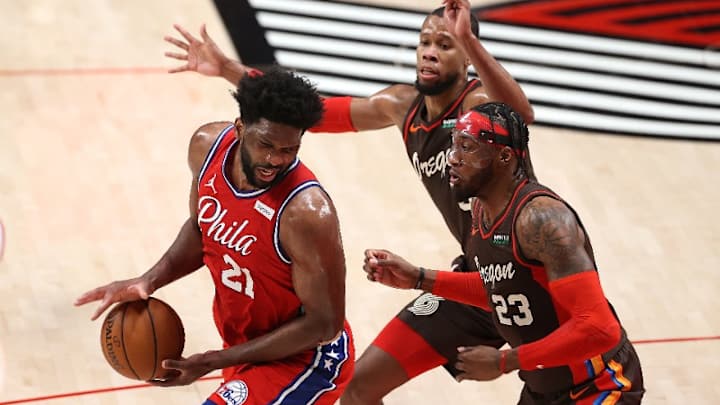Film Room: The Crunch-Time Adjustment That Fooled Joel Embiid And Helped Seal A Blazers Win

Carmelo Anthony's fourth quarter scoring outburst made the headlines, but it was defense as much as anything else that helped the Trail Blazers hold off the Sixers in crunch time on Thursday night.
Terry Stotts made no secret of his team's plans to double-team Joel Embiid on the block during pregame chats with media. Leaving most any defender on an island against Embiid, obviously, is a losing proposition.
He's shooting a gaudy 53.9 percent from the post this season, per NBA.com/stats, and drawing shooting fouls on over a quarter of those touches–easily the league's highest rate. Embiid's grown far more patient mapping the floor out of double-teams as a passer, too.
Those realities, especially combined with the absence of Jusuf Nurkic, made outcomes like below seem predetermined.
As Philadelphia fought back after Anthony lost the hot hand, Embiid was the driver of his team's offense, whether he was scoring or drawing extra defenders.
These were his last two touches on the block before Stotts called timeout with 4:15 left, his team up 108-107.
Take a look at all those possessions again, with special attention to how Portland's help defenders react. Every double-team comes from the nail, allowing Embiid to survey the middle of the floor while working with his strong hand.
During postgame media availability, Damian Lillard went into detail about Portland's late-game decision to change the look it was giving Embiid. The gist? The Blazers were no longer sending double-teams at Embiid from the nail, but from the baseline.
One of the things @Dame_Lillard credited for the win was changing up their defense on Embiid in the fourth quarter. They were doubling at the nail, switched to the baseline in the fourth.
— Casey Holdahl (@CHold) February 12, 2021
Sure enough, Embiid's final pair of post touches–following that timeout by Stotts, remember–left him as frustrated as he was suddenly ineffective.
A crucial and easily overlooked factor here: Ben Simmons' lack of shooting range making loading to the ball much easier for Portland.
Derrick Jones Jr. gets to Embiid so quickly on the second possession because Simmons, his man, is stationed in the dunker spot as opposed to the opposite corner. It's fair to say Jones' weak-side help from the same area in the previous clip spooked Embiid a bit, too.
The margin of error between winning and losing can be razor thin in the NBA. Sometimes, it really is the latest in-game adjustments that decide a game's outcome. Would the Blazers have still finished their homestand unblemished if Stotts hadn't made the change? Maybe.
But it's the little things that will help keep the Blazers afloat without C.J. McCollum and Jusuf Nurkic. At 14-10 and fifth place in the West despite another rash of injuries, Stotts and his team continue to do them.
